References
1. An Australian Government, State and Territory Health Initiative: Go for 2 fruit and 5 vegetables cited 2012 February 21. Available from
http://www.gofor2and5.com.au.
2. Agron P, Takada E, Purcell A. California project lean's food on the run program: an evaluation of a high school-based student advocacy nutrition and physical activity program. J Am Diet Assoc 2002. 1023 Suppl. S103–S105.
3. Arnold CG, Sobal J. Food practices and nutrition knowledge after graduation from the expanded food and nutrition education program (EFNEP). J Nutr Educ 2000. 32(3)130–138.
4. Auld GW, Romaniello C, Heimendinger J, Hambidge C, Heimendinger M. Outcomes from a school-based nutrition education program alternating special resource teachers and classroom teachers. J Sch Health 1999. 69(10)403–408.
5. Bae SJ, Lee SM, Ahn HS. Comparison of nutritional knowledge, dietary habits, and practice level of eating behavior guidelines between part-time working and non-working adolescents attending a vocational high school in Yongin, Gyeonggi-Do. Korean J Food Cult 2010. 25(1)17–24.
6. B-Bredbenner C, Shannon B, Hsn L, Smith DH. A nutrition education curriculum for senior high economics students: its effect on students' knowledge, attitudes and behaviors. J Nutr Educ 1988. 20(6)341–349.
7. Brush KH, Woolcott DM, Kawash GF. Evaluation of an affective-based adult nutrition education program. J Nutr Educ 1986. 18(6)258–264.
8. Chang HS, Roh SM. Comparison with dietary habits, dietary attitudes and nutritional knowledge according to sex of teenagers in Jeonnam province. Korean J Community Nutr 2006. 11(4)459–468.
9. Choi MK, Bae YJ, Kim MH, In SJ. A survey of the needs of nutrition education based on analysis of eating habits and nutrition knowledge among middle school students in Kyung-Gi province. J Korean Diet Assoc 2010. 16(2)133–145.
10. Ha JS, Lee HJ. Effect of middle school student's food behavior on health condition and degree of study accomplishment. J Korean Home Econ Assoc 1995. 33(3)225–242.
11. Ha MJ, Kye SH, Lee HS, Shin SJ, Kang YJ, Kim CI. Nutritional status of junior high school students. Korean J Nutr 1997. 30(3)326–335.
12. Ha TY, Kim HY, Kim YJ. Nutrition knowledge and food habit of middle school student's mothers. J Korean Soc Food Nutr 1995. 24(1)10–18.
13. Hong EK, Park SB, Shin YS, Park HS. Body image perception and self-reported weight control activities in adolescent girls. J Korean Acad Fam Med 1997. 18(7)714–721.
14. Joung HJ. Deteriorating nutritional status in an increasingly prosperous society. Korean J Nutr 2005. 38(9)777–785.
15. Jung BM, Choi IS. A study on obesity and food habit of adolescents in Yeosu, Jeonnam area. Korean J Community Nutr 2003. 8(2)129–137.
16. Kang HJ, Kim KM, Kim KJ, Ryu ES. Effect-evaluation of nutrition education program for the mothers of preschool children in kindergarten. Korean J Nutr 2001. 34(2)230–240.
17. Kang HW, Lee SS. A study on weight control and dietary life among middle school students: nutrition knowledge, dietary behavior and food frequency. Korean J Nutr 2006. 39(8)817–831.
18. Kang YH, Yang IS, Kim HY, Lee HY. Identifying the subjects of nutrition education for junior and senior high school students. Korean J Nutr 2004. 37(10)938–945.
19. Kim BH, Sung MY, Lee YN. Comparison of the nutrient intakes by the score of dietary action guides for Korean children among the elementary school students in Gwangju city. Korean J Community Nutr 2011. 16(4)411–425.
20. Kim HH, Park YH, Shin EK, Shin KH, Bae IS, Lee YK. Students' and parents' perceptions of nutrition education in elementary schools. J Korean Soc Food Sci Nutr 2006. 35(8)1016–1024.
21. Kim JS, Park MS, Cho YS, Lee JW. Effects of school-based nutrition education for Korean food guide on food intake frequency of adolescents. Korean J Community Nutr 2005. 10(5)582–591.
22. Kim KM, Lee SY. The study on nutritional knowledge and eating behavior of elementary school senior students in Incheon area. J Korean Diet Assoc 2000. 6(2)97–107.
23. Kim KM, Lee SY. A study on consciousness of administer and dietitians for school food-service management and nutritional education. J Korean Diet Assoc 2001. 7(2)129–137.
24. Kim SH, Hyun TS. Evaluation of a nutrition education website for children. Korean J Community Nutr 2006. 11(2)218–228.
25. Ko SY, Kim KW. Nutrition label use, self-efficacy, snacking and eating behavior of middle school students in Kyunggi area. Korean J Community Nutr 2010. 15(4)513–524.
26. Ku BJ, Lee KA. A survey on dietary habit and nutritional knowledge for elementary school children's nutritional education. Korean J Diet Cult 2000. 15(3)201–213.
27. Lee JE, Jung IK. A study on eating habits of elementary school students and the perception on the nutrition education in curriculum. J Korean Home Econ Educ Assoc 2005. 17(2)79–83.
28. Lee JS. The effects of gender, obesity rate, nutrition knowledge and dietary attitude on the dietary self-efficacy of adolescents. Korean J Community Nutr 2003. 8(5)652–657.
29. Lee MS, Sung CJ, Sung MK, Choi MI, Lee YS, Cho KO. A comparative study on food habits and nutrient intakes among high school students with different obesity indexes residing in Seoul and Kyunggi-do. Korean J Community Nutr 2000. 5(2)474–151.
30. Lewis M, Brun J, Talmage H, Rasher S. Teenagers and food choices: the impact of nutrition education. J Nutr Educ 1988. 20(6)336–340.
31. Lifshitz F, Tarim O, Smith MM. Nutrition in adolescence. Endocrinol Metab Clin North Am 1993. 22(3)673–683.
32. Lytle LA, Gerlach S, Weinstein AB. Conducting nutrition education research in junior schools: approaches and challenges. J Nutr Educ 2001. 33(1)49–54.
33. Ministry of Health and Welfare. Korea Health Industry Development Institute. Revision of dietary guidelines for Koreans with action guides for adults and the elderly 2002.
34. Ministry of Health, Welfare and Family Affairs. Korea Centers for Disease Control and Prevention. Ministry of Education Human Resources Development. The first Korea youth risk behavior web-based survey 2005 2006.
35. Ministry of Health and Welfare. Korea Health Industry Development Institute. The third Korea National Health and Nutrition Examination Survey (KNHANES III), 2005 - Nutrition Survey(I) 2006. Ministry of Health and Welfare;
36. Ministry of Health, Welfare and Family Affairs. Korea Centers for Disease Control and Prevention. 2007 National health statistics - The 4th Korea National Health and Nutrition Examination Survey, the first year 2007 2008. Korea: Korea Centers for Disease Control and Prevention;
37. Norton PA, Falciglia GA, Wagner M. Status of nutrition education in Ohio elementary schools. J Nutr Educ 1997. 29(2)92–97.
38. Paik HY, Kim CI, Moon HK, Yoon JS, Joung HJ, Shim JE, Jung HJ. 2008 Dietary goals and dietary guidelines for Korean adults. Korean J Nutr 2008. 41(8)887–899.
39. Park JY. Relevance of Eating Habit Guideline Practice Rate, Obesity and Snack Consumption Frequency 2010. Keimyung University; 28–34.
MS thesis.
40. Park YH, Kim HH, Shin KH, Shin EK, Bae IS, Lee YK. A survey on practice nutrition education and perception for implementing nutrition education by nutrition teacher in elementary schools. Korean J Nutr 2006. 39(4)403–416.
41. Park HR, Lee KH, Seo JS, Lee YK. Development of nutrition textbooks for middle and high school students. Research Report for the Korea Health Promotion Foundation 2011.
42. Rhie SG, Park HA, Jung EH. The effects of nutrition education on dietary behavior, nutrition knowledge and weight control of middle school students. Korean J Community Living Sci 2007. 18(3)469–480.
43. Ro HK. Comparisons of nutrient intakes, dietary behavior and perception about body image between adolescent boys and girls in rural area. Korean J Community Nutr 2000. 5(2)280–288.
44. Sims LS. Toward an understanding of attitude assessment in nutrition research. J Am Diet Assoc 1981. 78(5)460–466.
45. Shin EM, Yoon EY. A study on nutrients intake, physical and biochemical status of elementary school children in Taejon. J Korean Diet Assoc 1998. 4(2)212–224.
46. Spear BA. Adolescent growth and development. J Am Diet Assoc 2002. 1023 Suppl. S23–S29.
47. Stunkard A, d'Aquili E, Fox S, Filion RD. Influence of social class on obesity and thinness in children. JAMA 1972. 221(6)579–584.
48. Tanner JM. Growth and maturation during adolescence. Nutr Rev 1981. 39(2)43–55.
49. Yang IS, Kim EK, Choi IS. The development and effect-evaluation of nutrition education program for preschool children in child-care centers. Korean J Nutr 1995. 28(1)61–70.
50. Yang IS, Kim HY, Kang YH. Effectiveness of web-based nutritional education program for junior and senior high school students. Korean J Nutr 2004. 37(7)576–584.
51. Yeom CA, Kim HR, Park HR, Kim HS, Kim SA, Park OJ, Shin MK, Son SM. Parents and principals of elementary school with meal service want sound nutrition education program performed by dietitian. J Korean Diet Assoc 1995. 1(1)89–95.
52. Yon MY, Han YH, Hyun TS. Dietary habits, food frequency and dietary attitudes by gender and nutrition knowledge level in upper-grade school children. Korean J Community Nutr 2008. 13(3)307–322.
53. 5+ A Day Fresh Fruit and Vegetables - New Zealand cited 2011 November 14. Available from
http://www.5aday.co.nz.





